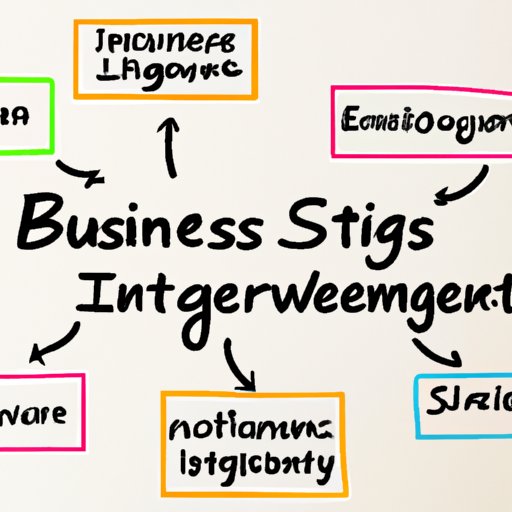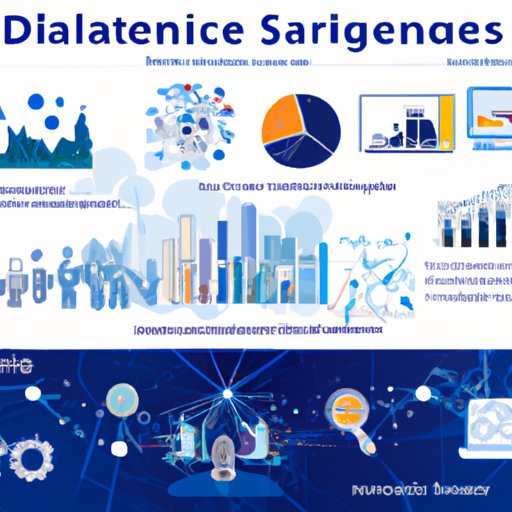Introduction
Business intelligence (BI) is an umbrella term used to describe the process of gathering, storing, analyzing, and visualizing data to make informed decisions. With the rise of big data, companies have been able to leverage business intelligence techniques to unlock valuable insights that can be used to improve operations, increase efficiency, and maximize profits. In this article, we will explore the various benefits of business intelligence techniques, provide a guide to selecting the right technique for your organization, and outline how to effectively implement a BI strategy.

Exploring the Benefits of Business Intelligence Techniques
By harnessing the power of data, businesses can gain a competitive advantage in the market. Here are some of the key benefits of leveraging business intelligence techniques:
Improved Decision Making
Having access to real-time data allows businesses to make better decisions based on accurate information. For example, with the help of business intelligence techniques, companies can identify which products or services are selling well, and focus their resources accordingly. This helps them stay ahead of the competition and maximize profits.
Enhanced Operational Efficiency
Business intelligence techniques allow companies to streamline their operations by reducing manual processes and automating tasks. This helps to reduce costs and increase productivity, leading to improved operational efficiency.
Increased Profitability
By leveraging business intelligence techniques, businesses can gain deeper insights into customer behaviour, market trends, and product performance. This enables them to identify areas for improvement and make necessary adjustments to increase profits.
A Guide to Selecting the Right Business Intelligence Technique for Your Organization
Selecting the right business intelligence technique for your organization depends on several factors, including goals and objectives, existing resources, and data sources. Here is a brief guide to help you select the best technique for your organization:
Identifying Goals and Objectives
The first step is to identify the goals and objectives of your organization. This will help you determine which business intelligence technique will be most beneficial for achieving those goals. For example, if you want to improve customer service, then a data mining technique may be more suitable than a data warehousing technique.
Evaluating Existing Resources
Once you’ve identified your goals and objectives, the next step is to evaluate your existing resources. This includes assessing the type of data you have access to, the tools you have available, and the skills and knowledge of your team. This will help you determine which business intelligence technique will be most suitable for your organization.
Assessing Data Sources
Finally, you need to assess the data sources you have access to. This will help you determine which business intelligence technique is best suited for extracting the most useful insights from your data. For example, if you have access to large amounts of structured data, then a data warehouse may be the best option.
An Overview of the Most Popular Business Intelligence Techniques
Now that you have a better understanding of the selection process, let’s take a look at some of the most popular business intelligence techniques:
Data Warehousing
Data warehousing is a technique used to store large amounts of structured data. It allows organizations to quickly access and analyze data from multiple sources, enabling them to make more informed decisions. Data warehouses are typically used for long-term data storage and analysis.
Data Mining
Data mining is a technique used to uncover patterns and correlations in large datasets. It can be used to discover hidden insights, such as customer behaviours, market trends, and product performance. Data mining is often used to improve decision making and operational efficiency.
Predictive Analytics
Predictive analytics is a technique used to forecast future outcomes based on historical data. It can be used to anticipate customer behaviour, predict market trends, and optimize operations. Predictive analytics can also be used to identify potential risks and develop strategies to mitigate them.
Visualization Tools
Visualization tools are used to present complex data in a visually appealing format. This makes it easier for users to understand the data and glean valuable insights. Visualization tools can be used to create charts, graphs, and maps, which can be used to monitor key performance indicators and identify opportunities for improvement.
Dashboards
Dashboards are used to display real-time data in an easy-to-understand format. This allows users to quickly monitor key metrics, identify trends, and make informed decisions. Dashboards can also be used to track progress and measure the success of campaigns.

Introducing Business Intelligence Techniques to Beginners
If you’re new to business intelligence techniques, it can be overwhelming to get started. Here are some tips to help you get up to speed:
Understanding Key Concepts
The first step is to gain a basic understanding of the key concepts related to business intelligence. This includes familiarizing yourself with terms such as data warehousing, data mining, predictive analytics, and visualization tools. You should also familiarize yourself with the different types of software and tools available.
Developing a Basic Strategy
Once you have a basic understanding of the key concepts, the next step is to develop a basic strategy. This involves identifying the goals and objectives of your organization, evaluating existing resources, and assessing data sources. This will help you determine which business intelligence technique is most suitable for your organization.
Choosing Appropriate Tools
The final step is to choose the appropriate tools and software to implement your strategy. There are many different options available, so it’s important to do your research and select the ones that are most suitable for your needs. Make sure to consider factors such as cost, usability, scalability, and security when making your decision.
Using Business Intelligence Techniques to Maximize Efficiency
Business intelligence techniques can be used to automate tasks and streamline processes, resulting in improved efficiency. Here are some tips to help you maximize efficiency:
Automating Tasks
Business intelligence techniques can be used to automate mundane tasks, freeing up time and resources for more meaningful work. Automation also helps to reduce errors and improves accuracy, resulting in higher quality output.
Streamlining Processes
Business intelligence techniques can be used to simplify complex processes, resulting in improved efficiency. By breaking down processes into smaller, more manageable tasks, businesses can reduce complexity and improve workflow.
Enhancing Collaboration
Business intelligence techniques can be used to facilitate collaboration between teams and departments. This helps to reduce confusion and miscommunication, leading to faster decision making and improved productivity.

How to Implement a Business Intelligence Strategy
Implementing a successful business intelligence strategy requires careful planning and execution. Here are some tips to help you get started:
Defining Clear Goals
The first step is to define clear goals and objectives for your business intelligence strategy. This will help you determine which techniques and tools are most suitable for achieving those goals. It will also help you measure the success of your strategy.
Setting Up an Effective Data Infrastructure
The next step is to set up an effective data infrastructure. This includes establishing secure data storage, creating efficient data processing pipelines, and developing robust data governance policies. Having a strong data infrastructure is essential for any successful business intelligence strategy.
Establishing Data Governance
Data governance is the process of ensuring that data is collected, stored, and processed in accordance with legal and ethical standards. Establishing a data governance policy will help to ensure that your data is reliable and secure.
Creating a Robust Reporting System
Reporting is an essential part of any business intelligence strategy. Creating a robust reporting system will help you extract valuable insights from your data and make informed decisions. It will also help you track progress and measure the success of your strategy.
Utilizing Artificial Intelligence
Artificial intelligence (AI) can be used to improve the accuracy and speed of data analysis. AI-powered tools can automate tedious tasks and uncover hidden patterns in data, helping to maximize efficiency and improve decision making.
Conclusion
Business intelligence techniques can be used to unlock valuable insights from data, enabling businesses to make better decisions and maximize profits. In this article, we explored the various benefits of business intelligence techniques, provided a guide to selecting the right technique for your organization, and outlined how to effectively implement a BI strategy. We hope this article has given you a better understanding of business intelligence techniques and how they can be used to improve operations and increase efficiency.
(Note: Is this article not meeting your expectations? Do you have knowledge or insights to share? Unlock new opportunities and expand your reach by joining our authors team. Click Registration to join us and share your expertise with our readers.)
